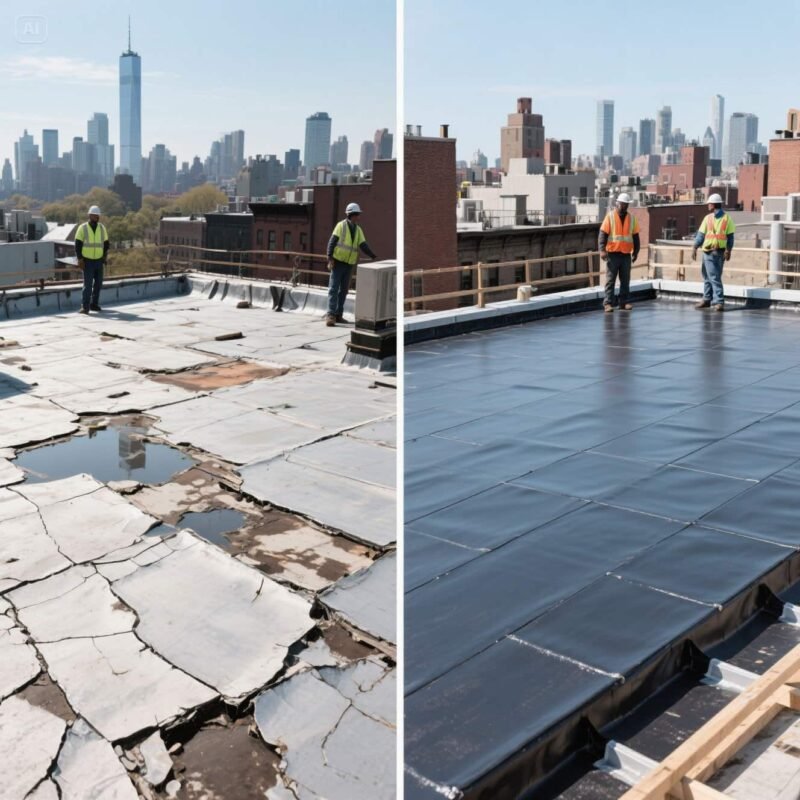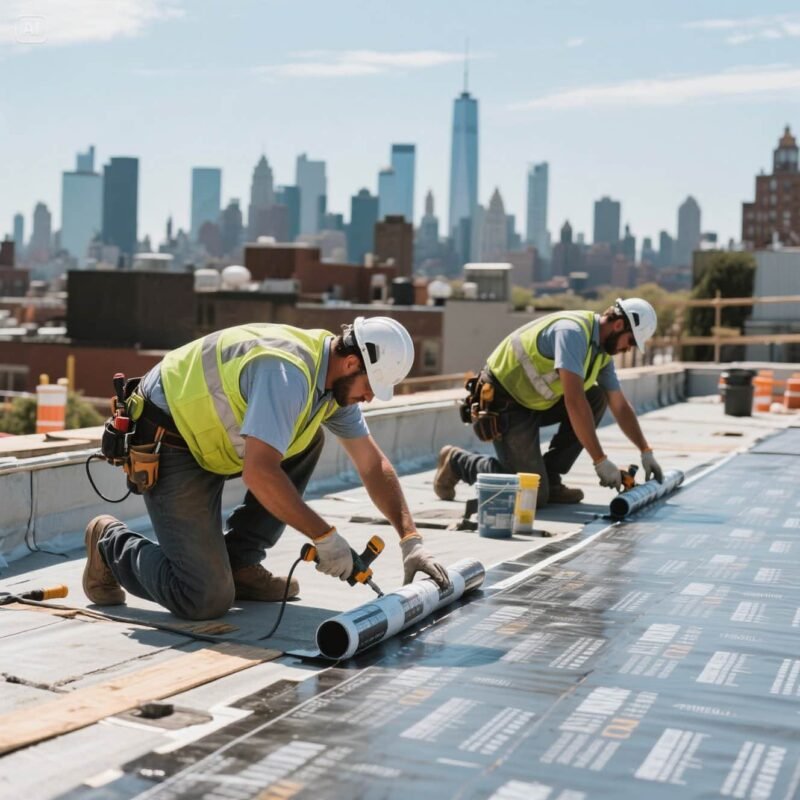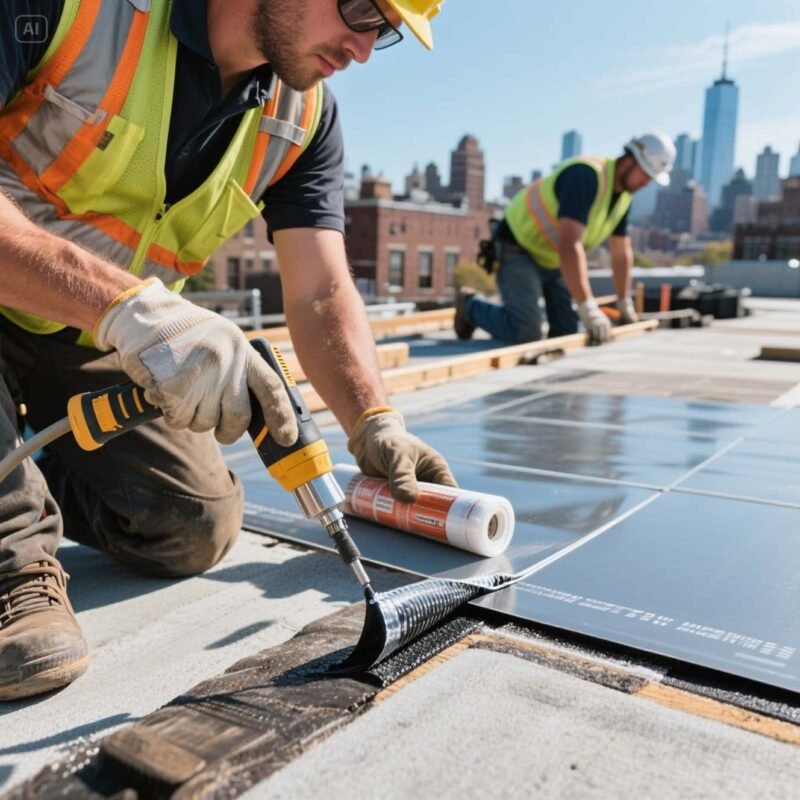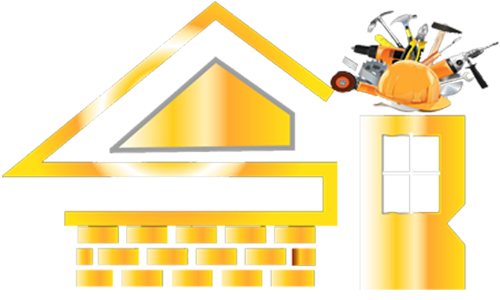Have you ever wondered what flat roofing is? Flat roofing is a type of roof that’s almost level. It has a slight slope to help water drain off. This design is standard in commercial buildings and modern homes. Unlike sloped roofs, flat roofs offer extra space. You can use the roof for a garden, a lounge area, or even solar panels.
Why should you choose a flat roof replacement service? Flat roofs can face many issues over time. Leaks, cracks, and water pooling are common problems. A new roof increases your home’s value, improves energy efficiency, and gives your property a fresh look. If your flat roof is old or damaged, replacement is the best choice.
Key Informations!
- Flat roofs are almost level, with a slight slope to allow for water drainage, and are often used in commercial buildings and modern homes.
- Flat roof replacement is necessary when repairs are no longer effective or the roof is over 20 years old, due to issues such as leaks and damage.
- Signs for replacement include frequent leaks, water pooling, cracks, sagging decks, mold growth, and increased energy bills.
- Flat roof replacement enhances durability, energy efficiency, and curb appeal, providing long-term savings and improved protection.
- Selecting materials such as EPDM, TPO, or PVC ensures durability, UV resistance, and improved energy efficiency in Brooklyn’s weather conditions.
- Roof replacement methods, such as the tear-off method, provide thorough results. Still, re-covering is faster and more cost-effective for minor issues.
- The cost of replacement in Brooklyn varies based on the materials used, with prices ranging from $5.50 per square foot for EPDM to $8.00 per square foot for PVC.
- Roof repairs may be an option for minor damage, but they will only provide a temporary fix and could lead to higher long-term costs.
- Green roofs and roof coatings offer eco-friendly alternatives, providing insulation and reducing water runoff, albeit at a cost.
- Regular maintenance is crucial to extend the lifespan of a roof and delay complete replacement by catching minor issues early.
When Should I Replace My Flat Roof in Brooklyn, NYC?
It can be challenging to determine when to replace your flat roof. The versatile weather of Brooklyn, with its cold winters and hot, humid summers, can damage your roof. If you notice any cracks, leaks, or signs of aging, it may be time to replace your roof.
Replace your roof if it is over 20 years old, although some materials last longer. If repairs no longer work or leaks keep coming back, it’s time for a new roof. Don’t let minor problems turn into big, expensive ones.
10 Signs of Flat Roof Replacement
- Frequent Leaks: Leaks are one of the biggest signs that it’s time for a replacement. If your roof has multiple leaks that keep coming back, patching them up won’t do the job for long. Persistent leaks could also signal that the underlying layers of your roof are damaged beyond repair.
- Water Pooling: Water pooling on a flat roof is normal, but it should not stay there. If water doesn’t drain properly and continues to collect, it can damage the roof and cause leaks. This can weaken the roof, so consider replacing it if pooling occurs frequently.
- Cracks and Blisters: Over time, roofing materials can develop cracks or blisters. These indicate that the membrane has deteriorated, allowing moisture to become trapped inside. If you spot large cracks or blisters, it’s a clear indication that your flat roof needs to be replaced to prevent further damage.
- Sagging Roof Deck: A sagging roof deck is a big concern. If the deck feels weak or starts to bend, it could eventually collapse. This typically occurs due to water damage or excessive weight on the roof. It’s important to replace the roof to keep your home safe and prevent further damage.
- Moss or Mold Growth: If you notice mold or moss growing on your roof, this may indicate trapped moisture. Mold and moss can damage roofing materials and affect indoor air quality. These are clear signs that your roof’s materials are no longer protecting your home correctly.
- Deteriorating Membrane: The membrane of your flat roof is designed to protect against leaks. If it starts to crack, peel, or become brittle, the roof is no longer serving its intended purpose. Replacing the membrane is often necessary to ensure your home stays dry and protected.
- Foul Odors: If you notice a musty, damp smell in your home, it may indicate that moisture is seeping through your roof. Leaks or water damage might have caused mold or rot to form. Replacing the roof will eliminate those odors and protect your home from further damage.
- Visible Sun Damage: The sun can damage your roof over time. Notice your roof fading, cracking, or appearing damaged due to sun exposure. It may be time to consider replacing it. A new roof will help protect it from further damage caused by UV rays.
- High Energy Bills: A flat roof that isn’t well-insulated or damaged can lead to high energy bills. If you notice higher heating or cooling costs, your roof might not be keeping your home properly insulated. Replace it with better materials to lower your energy expenses.
- Increased Repair Costs: If you’re incurring constant repairs, it may be more cost-effective to replace the roof. Constantly fixing leaks or damage can get expensive. In the long run, a replacement will save you money.

What Are the Benefits of Flat Roof Replacement?
Flat roof replacement offers numerous advantages. A new roof not only solves current issues but also adds long-term value to your property. You can enjoy better protection, lower maintenance costs, and improved energy efficiency. Here are the key benefits of flat roof replacement:
- Improved Durability: A new roof is built to last longer. It can resist weather conditions, like heavy rain and snow, which Brooklyn often experiences. With a fresh roof, you’ll avoid frequent repairs and costly fixes.
- Better Energy Efficiency: A new roof can help regulate the temperature in your home. Proper insulation and modern roofing materials keep the heat inside during the winter and cool air during the summer. This reduces your energy bills.
- Enhanced Curb Appeal: A new roof setup can improve your home’s appearance. A fresh, well-maintained roof adds a modern, polished look. It can make a big difference if you’re planning to sell your property.
- Increased Property Value: A new roof raises the value of your home. Potential buyers will appreciate knowing that they won’t need to replace the roof anytime soon. This makes your property more attractive in the market.
- Fewer Repairs: Roof renewal reduces the need for frequent repairs. You won’t need to deal with patching leaks or fixing damaged areas on a regular basis. A new roof provides peace of mind.
- Improved Safety: An old or damaged roof can pose significant safety risks, including leaks and structural damage. Replacing it ensures your home is safe for you and your family. You reduce the chance of mold growth, water damage, or roof collapse.
- Long-Term Savings: A new roof can save you money over time. You won’t face constant repairs, and your energy bills will be lower. The investment in a new roof pays off with fewer future costs.
- Eco-Friendly: Many new roofing materials are environmentally friendly. By choosing sustainable materials, you help reduce your carbon footprint. Some roofing options even help with water collection for eco-conscious living.
10 Things to Consider Before Replacing Your Flat Roof
Before replacing your flat roof, consider the following important factors. Making the right decisions will help ensure that you get the best result for your home and budget. Here are ten things to keep in mind:
- Material Choice: Choosing the right roofing material is vital. Options like EPDM, TPO, and PVC offer different benefits. Ensure the material suits your budget and is suitable for Brooklyn’s weather conditions.
- Roofing Contractor: Find a reliable roofing contractor with experience in flat roof replacements. Look for someone with good reviews and proper certifications. A skilled contractor will ensure the job is done correctly.
- Cost: Consider the full cost of replacement. Get quotes from multiple contractors to compare prices. Don’t forget to factor in materials, labor, and any potential repairs.
- Roof Condition: Assess the condition of your current roof. If the deck is damaged, it will need repairs before installing a new roof. Ensure that you check the foundation before starting the replacement process.
- Roof Slope: The slope of your roof is vital for proper drainage. If water tends to pool on your roof, it could cause future issues. Adding or adjusting the slope during replacement may be necessary.
- Weather Conditions: Replace your roof in the right weather. Aim for a dry, mild period to avoid complications. Avoid replacing your roof during heavy rain or snow to ensure proper installation and avoid potential issues.
- Energy Efficiency: Consider how the new roof will affect your home’s energy efficiency. Upgrading insulation and choosing reflective materials can reduce energy costs. A more energy-efficient roof can save you money in the long run.
- Warranty: Ask about the warranty options for your new roof. A solid warranty protects you from any event of defects or issues. Always clarify what’s covered for how long.
- Permits and Regulations: Check with your local authorities about necessary permits. Replacing a roof in Brooklyn may require approval. Make sure you meet local building codes to avoid fines or delays.
- Maintenance Plan: Schedule regular maintenance after you install your new roof. Periodic inspections will help you catch minor issues before they become major problems. Proper roof maintenance ensures it will last for many years.
How Do You Replace a Flat Roof: Step-by-Step Process
A flat roof installation requires a detailed process to ensure proper results. The work is complex and requires skilled professionals to handle each step with care. Here’s a brief of the flat roof replacement process.
1. Roof Inspection and Evaluation: The first step in replacing your flat roof is a thorough inspection. Roofing professionals check the roof for damage and underlying issues. They look for signs of leaks, structural damage, or weakness in the roof deck. This evaluation helps determine the extent of the work needed.
2. Removal of the Old Roof: After the inspection, you must remove the old roof. The roofing team carefully strips away the old roofing materials. This could involve removing the membrane, insulation, and even parts of the decking if they are damaged. Proper disposal of old materials is also essential during this phase.
3. Deck Inspection and Repair: Once you remove the old roof, inspect the deck. The roof deck, or the base of the roof, must be solid and stable. If there are any’s, such as rotting wood or weakened sections, they must be repaired or replaced. This ensures the new roof has a stable foundation.
4. Installing Insulation: Insulation is crucial for energy efficiency. In many cases, contractors install new insulation during a roof replacement. This helps keep your home comfortable by regulating the temperature. It also plays a role in reducing energy bills. Proper insulation helps keep the heat in during winter and the cool air inside during summer.
5. Installing the New Roof Membrane: The next step is installing the new roofing membrane. You can make this from materials such as EPDM, TPO, or PVC. The roofing material is rolled out and securely fastened to the roof deck. It’s sealed to prevent leaks and ensure durability.
6. Flashing Installation: Flashing is essential to seal around edges, chimneys, vents, and other roof features. It helps prevent water from leaking into these areas. Proper installation of flashing is crucial for keeping your home dry and preventing water damage.
7. Edges and Sealing: The roof’s edge is sealed to prevent water from entering. The edges are treated carefully, as this is where leaks can often occur. Proper sealing ensures the roof is fully waterproof.
8. Final Inspection: Once the roof is fully installed, a final inspection is carried out. The roofing professionals check for any imperfections or areas that need adjustment. This ensures everything is done correctly, and the roof is ready for use.
9. Clean-Up: After the installation, the area around your home is cleaned up. The workers will remove any debris, old materials, and equipment. A clean worksite is important for both safety and presentation.
Expert’s Tips
Always choose high-quality materials suited for your local climate. Work with experienced professionals to avoid common mistakes like poor drainage or improper insulation. Regular inspections after installation will help catch potential issues early.

Flat Roof Replacement Cost (Per Square Ft.) in Brooklyn, NYC
When considering flat roof replacement in Brooklyn, NYC, it’s important to know the costs. The price can vary based on the material type, the size of your roof, and the labour costs. Here is the cost list:
| Material Type | Material Cost (per sq. ft.) | Labor Cost (per sq. ft.) | Total Cost (per sq. ft.) |
| EPDM (Rubber) | $3.50 | $2.00 | $5.50 |
| TPO (Thermoplastic) | $4.00 | $2.25 | $6.25 |
| PVC (Vinyl) | $5.00 | $3.00 | $8.00 |
| Modified Bitumen | $3.75 | $2.50 | $6.25 |
| Built-Up Roofing (BUR) | $4.25 | $2.75 | $7.00 |
Flat Roof Replacement vs. Repair: Which One Is Preferable in Brooklyn Weather?
Here is a comprehensive comparison between flat roof replacement and repair. Now you choose which one is preferable!
| Criteria | Replacement | Repair |
| Cost | Higher initial cost, but long-term savings | Lower cost upfront, but ongoing repairs may add up |
| Longevity | 20-30 years or more | Temporary fix, may need redoing in 5-10 years |
| Energy Efficiency | Improved insulation and performance | Depends on the extent of repair; may not improve efficiency |
| Protection from Weather | Full protection against elements | May leave weak spots if not thoroughly repaired |
| Speed of Work | Takes longer to complete | Faster process, can be done quickly |
| Impact on Property Value | Increases value with new roof | No significant impact on resale value |
| Best for | Severe damage, old roofs, long-term investment | Minor issues, smaller budgets, temporary fixes |
Types of Flat Roof Replacement Materials
The right flat roof material is essential for durability, energy efficiency, and cost. Different materials offer unique advantages depending on your needs and budget. Here are some of the most common flat roofing materials:
- EPDM (Ethylene Propylene Diene Monomer): EPDM is a synthetic rubber roofing material known for its durability and weather resistance. It is ideal for protecting against UV rays, ozone, and harsh weather. EPDM is also one of the more affordable options, making it a popular choice for flat roofs. It requires minimal maintenance and can last up to 30 years.
- TPO (Thermoplastic Olefin): TPO is a heat-reflective and energy-efficient roofing material. It is a single-ply membrane that helps lower cooling costs by reflecting sunlight. TPO is resistant to punctures, tears, and chemicals, making it a long-lasting option. This material also has a higher resistance to UV degradation compared to other materials.
- PVC (Polyvinyl Chloride): PVC is a strong, durable roofing material that is highly resistant to water, chemicals, and fire. This material is a popular choice for commercial properties. PVC roofs are lightweight, energy-efficient, and can last over 30 years when properly maintained. It is also available in a variety of colors to reflect heat.
- Modified Bitumen: Modified Bitumen is a multi-layered roofing system made from asphalt and rubber polymers. This material is known for its excellent waterproofing and UV resistance. It is highly durable and often used in areas with extreme weather conditions. Modified bitumen roofs are easy to install but may require more maintenance than other options.
- Built-Up Roofing (BUR): Built-Up Roofing is a traditional option that involves layers of tar, Bitumen, and gravel. This material is highly durable and can withstand heavy foot traffic and harsh conditions. BUR roofs are known for their long lifespan and are good at resisting water damage. However, they are more labor-intensive to install and can be heavier than other roofing types.
Types of Flat Roof Replacement Methods
The right installation method for your flat roof is just as important as selecting the material. Here are the most common methods used for flat roof replacement, along with their pros and cons:
- Tear-Off Method
- This method involves completely removing the old roof before installing a new one. It is the most thorough approach and allows contractors to check the roof deck for damage.
- Advantages:
- Provides a clean slate for a new roof.
- Allows for a full inspection of the deck.
- Reduces the risk of future problems with the old roofing layers.
- Disadvantages.
- More labor-intensive and time-consuming.
- Higher upfront cost due to removal and disposal.
- Re-Covering Method
- Re-covering involves adding a new layer of roofing material over the existing roof. This method is quicker and less expensive.
- Advantages:
- Lower cost than a full replacement.
- Faster installation process.
- Minimal disruption to your property.
- Disadvantages.
- May trap moisture between layers, leading to future problems.
- Not recommended if there is significant damage to the existing roof.
- Advantages:
- Green Roof Installation
- A green roof involves planting vegetation on top of the roof membrane. It creates a natural barrier. This method can be both aesthetically pleasing and environmentally friendly.
- Advantages:
- Provides excellent insulation and energy efficiency.
- Reduces water runoff and helps the environment.
- Increases the longevity of the roof membrane.
- Disadvantages:
- Expensive initial cost.
- Requires additional maintenance for the plants.
- Advantages:
- Roof Coating Method
- Roof coatings involve applying a reflective layer over the existing roof and extending its lifespan without the need for complete replacement.
- Advantages:
- Cost-effective solution for minor damage.
- Reflects UV rays, reducing cooling costs.
- Faster and easier than a full roof replacement.
- Disadvantages:
- Not suitable for roofs with significant damage.
- It may need to be reapplied every few years.
- Advantages:

Alternatives to Flat Roof Replacement in Brooklyn, NYC
If you’re not ready to replace your flat roof just yet, there are several alternatives you can consider. These options are typically more affordable and can help extend the life of your roof. Here’s what:
Roof Coatings: Roof coatings are a great way to extend the life of your flat roof without full replacement. They can seal up small cracks and leaks, provide UV protection, and even improve the roof’s efficiency. You can apply coatings such as silicone, acrylic, or elastomeric, depending on your roof’s condition and your specific needs.
Roof Patches: If your flat roof has localized damage, patching it up might be a good alternative. This is usually cheaper and faster than a full replacement. Patches can cover holes, cracks, or other small problem areas. It helps to prevent leaks and further damage. However, patches are only effective if the damage is limited.
Roof Restoration: Roof restoration involves a more thorough approach than a simple coating. It often includes cleaning, repairing, and sealing the entire roof to restore its original strength. This can significantly increase the roof’s energy efficiency.
Green Roof Installation: A green roof is an environmentally friendly alternative. While it requires a more substantial initial investment, it provides excellent insulation and helps with stormwater management. The added benefit of a green roof is the aesthetic appeal and potential for a rooftop garden or leisure area.
Flat Roof Maintenance Plans: Regular maintenance can go a long way in preventing the need for replacement. This includes inspections, cleaning, sealing, and clearing drains. By keeping your roof in good shape, you can delay a full replacement for many years. Maintenance can save you money by catching small issues before they turn into larger, costlier problems.
Where to Find a Professional Roofing Contractor in Brooklyn, NYC?
Are you looking for an expert roofing contractor in Brooklyn, NYC? SR General Construction has you covered! Our business is located at 8807 Avenue B, Brooklyn, NY 11236, United States, in the Canarsie area.
We proudly serve all areas of Brooklyn with high-quality, durable roofing solutions. From new installations to repairs and maintenance, we provide the best service at affordable prices. Contact us and experience why we’re Brooklyn’s roofing experts!
FAQ’s
1. What is flat roofing?
Flat roofing is a roof system that is nearly horizontal, with a slight pitch to allow water drainage. This design is commonly used in commercial buildings and modern homes. It offers additional space, ideal for gardens, lounge areas, or solar panel installations.
2. What are the signs that my flat roof needs replacing?
Signs include persistent leaks, water pooling that doesn’t drain, blisters, sagging decks, visible mold or moss growth, high energy bills, and increased repair costs. If you notice these signs, it’s time to consider a replacement to prevent further damage and costly repairs.
3. How long does a flat roof typically last?
The lifespan of a flat roof varies by material, but typically, a flat roof can last between 20 and 30 years. With proper maintenance, certain materials may even last longer. Without maintenance, damage can occur more quickly, shortening the lifespan.
4. What is the cost of replacing a flat roof in Brooklyn?
The cost of replacing a flat roof in Brooklyn ranges from $5.50 per square foot for EPDM to $8.00 per square foot for PVC. The final price depends on the material, roof size, and labor costs. You should also account for any necessary repairs to the deck, as well as additional features such as flashing and insulation.
5. What is the difference between flat roof replacement and repair?
Roof replacement involves removing the old roof and installing a new one that provides long-term protection and durability. On the other hand, Roof repairs address small issues like leaks and cracks but only offer a temporary fix. Replacement is ideal for roofs with significant damage or when repairs no longer resolve ongoing issues.
6. When is the best time to replace my flat roof in Brooklyn?
The best time to replace a flat roof in Brooklyn is during the dry spring or fall months when the weather is mild. Avoid replacement during extreme winter or rainy seasons, as these can delay installation and affect the roof’s long-term performance.
7. How long does it take to replace a flat roof?
The time needed to replace a flat roof depends on the size of the roof, the materials used, and weather conditions. On average, it takes anywhere from 2 to 5 days to complete the replacement, but the process may take longer if the deck requires significant repairs.
8. What is the difference between EPDM, TPO, and PVC?
EPDM is a durable rubber material that’s cost-effective and resistant to UV rays. TPO is a reflective material that improves energy efficiency and resists punctures. PVC is strong, fire-resistant, and ideal for commercial roofs; however, it tends to be more expensive than EPDM and TPO.
